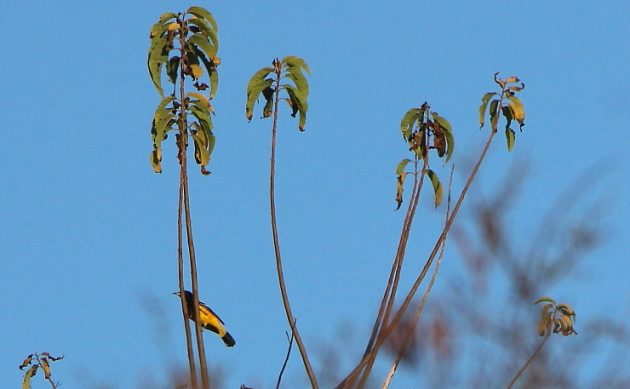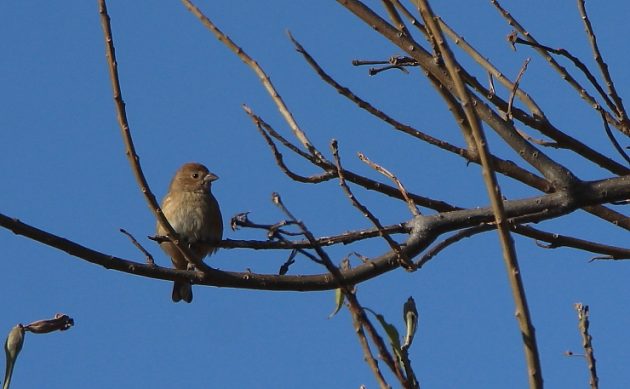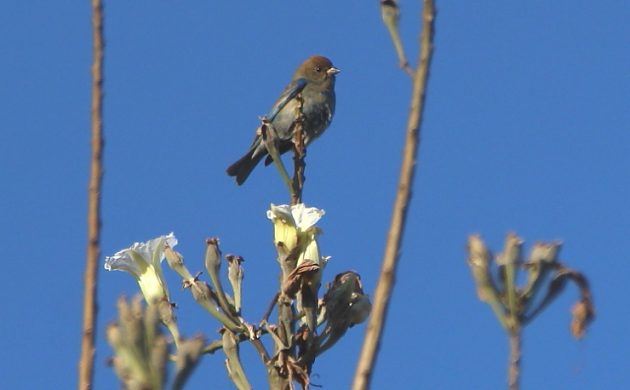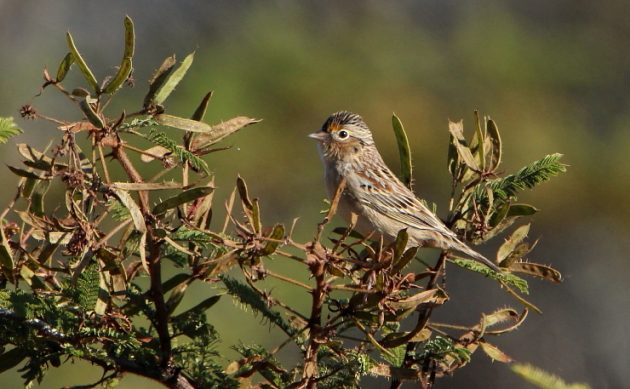
As anyone who knows quality photography can tell, I am not the sort of birder who tends to stay in one place for long. There are no photographic hides or tripods for me. I am always off to see what the next spot might have to offer, rather than taking the whole day searching for that one perfect shot from a single location.
Still, even hyperactive birders occasionally stumble on that one spot that is so birdy you just can’t move on. Sometimes, that one spot is a single tree.
That is what happened to me on Monday, December 14th. I was on my way to El Temascal, one of my favorite sites. But as I entered the first pine-oak woods on the way there, the very first big Michoacán Pine had a Red-tailed Hawk sticking out of its crown. What could I do? I had to stop and take a few photos. And when I did, I discovered that I was standing in the middle of a winter wonderland of birdsong. This spot had to be further investigated!

And here he (or, more likely, she) is, in the early morning light.
At first, I was doing my usual scattershot visuals, looking every which way for the sources of all those calls. And indeed, there were birds everywhere. But gradually, I worked my way up the ridge above the highway. Eventually, I discovered a most unusual amount of activity centered around a single tree up the hill, with the added bonus that the morning sun was shining from behind me, giving everything on the tree an unusual amount of color and definition.
The tree in question turned out to a Cazahuate (kah-sah-WAH-tae), Ipomea arborescens. Interestingly, this tree is a close relative of Morning Glories and Sweet Potatoes, with over 600 species making up their single genus. It wasn’t much to look at, since these trees drop their leaves during our winter dry season. Even it’s flowers were mostly spent; I’ve seen Cazahuates covered with open flowers, but this one certainly wasn’t. Clearly, I do not appreciate what birds appreciate.
I already knew that these common trees are Hummingbird magnets, and was not at all surprised that the two species visiting it were the Broad-billed Hummingbird, which I can also see in my Morelia garden, and the Violet-crowned Hummingbird, lover of dry highland habitats:

My photo of the Broad-billed Hummingbird on the Cazahuate isn’t worth showing here. But this shot of the same bird, taken nearby, has already rocketed to the top of my favority BBHU photos.

The Violet-crowned Hummingbird clearly did not want his portrait taken.
And I wasn’t that surprised to see plenty of Oriole activity around its flowers. What did surprise me was how many species were visiting this one tree: a lone Scott’s Oriole nearby did not make it to the tree, as far as I could tell, but several Bullock’s and Hooded Orioles did, as well as a seemingly endless supply of our endemic Black-vented Orioles (distinguished by a complete lack of wing bars):

This Scott’s Oriole could be confused with a Black-vented Oriole. But a close examination of the photo revealed white wing bars.

You won’t find wing bars on any Black-vented Orioles.

For some reason, all the Hooded Orioles were females…

…and so were all the Bullock’s Orioles.
And then there were all the visitors that I would never have expected to find on this leafless, flowering tree: Red-headed Tanagers, an Eastern Bluebird, one Blue Grosbeak, Black-headed Grosbeaks, Chipping Sparrows, a pair of House Finches, Lesser Golfinches, a Yellow-rumped (Audubon’s) Warbler, a female Western Tanager, one Varied Bunting, and several Indigo Buntings. (This winter is turning into my season of Indigo Buntings.)

Boy, that early morning sunlight made the male Red-headed Tanager’s head color pop!

This Eastern Bluebird was looking good, also.

Left to right: two Black-vented Orioles, one Blue Grosbeak, and a female Hooded Oriole. All in one tree!

With a close-up of that beautiful male Blue Grosbeak, and Ms. Hooded

Chipping Sparrow

This is what a male Lesser Goldfinch looks like in central Mexico. In California, they have a greenish back.

Yellow-rumped Warbler (Audubon’s)

a female Western Tanager

A female Varied Bunting

This is a typically blotchy-colored winter male Indigo Bunting. He brought friends.
Since I can’t leave well enough alone, I’ll throw in a photo of a Grasshopper Sparrow that definitely did not visit my Wonder Tree. Grasshopper Sparrows normally act rather like quail, hiding in deep brush until one’s presence causes them to flush briefly and then dive back out of sight. So I felt privileged to see this one perching in plain sight. Plus, Grasshopper Sparrows are unusually beautiful sparrows.












Thank you once again, Paul, for the vicarious birding experience. I so appreciate your photos and narrative. I usually forward your posts to those with whom I’ve birded in Mexico. We all miss our annual Latin American birding this year.
Ruth
Thanks so much, Ruth. I hope this year you are able to make up for birding in Latin America with lots of outings wherever you call home.
I’m glad to read that there are other hyperactive birders out there! I love novelty and trying to find new birding spots, so if I start going somewhere repeatedly there’s a good chance it must be birdy!
Paul,
I too am in Morelia and would love to learn more about birding down here. We see white water birds fly east in the am and west in the pm outside our upstairs window looking toward Camelinas off of Ventura Puente and am so curious as to who they are!
Thank you for your posts. I have yet to see a hawk down here!
Hi Delora. Those are Cattle Egrets, an invasive species that are common everywhere here. Unlike all our other Egrets and Herons, Cattle Egrets are actually much more interested in livestock than in standing water.